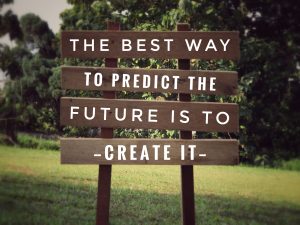In recent years, the idea of manifestation, the belief that you can create your reality through thought and intention, has become very mainstream due to the publication of popular books like The Secret and The Law of Attraction. The once very “woo-woo” subject has been broken down, explained, and become more grounded. Leaders and successful entrepreneurs like Oprah Winfrey swear by manifestation and its role in their success. While science is still catching up with this practice, research is beginning to support this concept.
What Manifestation Is
 Before diving into creating the life and business you desire most, it’s essential to understand what manifestation is and is not. Technically speaking, “manifestation” means bringing an idea to reality. Through practicing manifestation, it is believed that you can draw your desires towards yourself by aligning your thoughts and ideas. Manifesting is typically done through daily practices around mindset, gratitude, and intention. Essentially, it is a holistic approach to goal setting.
Before diving into creating the life and business you desire most, it’s essential to understand what manifestation is and is not. Technically speaking, “manifestation” means bringing an idea to reality. Through practicing manifestation, it is believed that you can draw your desires towards yourself by aligning your thoughts and ideas. Manifesting is typically done through daily practices around mindset, gratitude, and intention. Essentially, it is a holistic approach to goal setting.
What Manifestation Is Not
Manifestation is not sitting around waiting for your daydreams to come true. While this idea sounds great, you won’t see the results you’re striving for without action to back it up. Unfortunately, this misconception and misinformation around the daydreamy aspect of this practice often give it a lousy reputation. Contrary to some beliefs, attracting your dream life requires conscious action, effort, and intention to work successfully.
3 Ways to Start Manifesting
Write Down Your Goals
An easy way to attract your dream life or business is by clearly explaining your goals and writing them down. A noteworthy manifestation practice supporting you in this is “future self-scripting.” For this practice, you must:

- Pull out a journal
- Write your goals in the present tense as if they have already happened. For example, if you are trying to bring in more income in your business, you could get very specific about how that would make you feel, what you would do with the money, and how your life would look.
Have fun with it, and allow yourself to dream and get excited!
After writing your goals, you must believe you can achieve them and create a plan to get there! Research shows that our expectations, negative or positive, tend to be confirmed. If we expect to bring our idea to life or reach our goal, we’re more likely to.
Make A Vision Board
 The practice of creating a vision board is prevalent within the world of consciously creating your reality. A vision board can act as a visual representation of your goals, dreams, and desires. These boards typically have goal-related pictures, words, or phrases on them. They are easy and affordable to make. All you have to do is:
The practice of creating a vision board is prevalent within the world of consciously creating your reality. A vision board can act as a visual representation of your goals, dreams, and desires. These boards typically have goal-related pictures, words, or phrases on them. They are easy and affordable to make. All you have to do is:
- Select pictures online or in a magazine that represent the goals you are currently working on achieving
- Cut them out and paste them on a poster board. For example, if you are trying to manifest your first 10k month, you can select an image of “$10,000,” or if you are hoping to get to a point in your business where you get to go on a free trip to a tropical place, you would select pictures of this destination and put them on your board.
- Place it somewhere you will see it often. For some people, it might be their phone. Here are five vision board apps.
When you look at your vision board, you should feel reminded, re-inspired, and excited about the reality you are creating!
Practice Gratitude
 It is believed that practicing Gratitude speeds up the process of manifesting your desires. Why? Because those who regularly practice gratitude have proven to feel happier! Why does this matter when manifesting? Because research done by Dr. Barbara Fredrickson shows that people who are generally happy and positive attract more opportunities, have better relationships, and seem to be able to manifest what they set their minds to more easily.
It is believed that practicing Gratitude speeds up the process of manifesting your desires. Why? Because those who regularly practice gratitude have proven to feel happier! Why does this matter when manifesting? Because research done by Dr. Barbara Fredrickson shows that people who are generally happy and positive attract more opportunities, have better relationships, and seem to be able to manifest what they set their minds to more easily.
Check out this gratitude journal to implement this powerful practice into your life!
Conclusion
Every freelancer, independent contractor, and small business owner deserves to create the life and business of their dreams! These three manifestation techniques work for most people and are a great place to get started if you’re new to the practice! Try them out and determine which ones you enjoy most. Maybe you’ll find some you don’t resonate with — that’s okay. Find what works best for you, stay consistent, and watch your life, business, and mindset shift!
Join NFICA Today
With Omicron running rampant, there has never been a better time to talk to a doctor from the safety of your own home.
 Whether you or a family member are experiencing symptoms, a visit with a doctor may be out of reach. HealthiestYou by Teladoc is just the answer!
Whether you or a family member are experiencing symptoms, a visit with a doctor may be out of reach. HealthiestYou by Teladoc is just the answer!
At only $9 a month, you get 24/7 unlimited access to over 8,000 U.S. board-certified doctors via phone or video chat. Doctors can diagnose, treat and prescribe medicine.
For just $9 a month, here’s what you get:
- Unlimited access to a network of over 8,000 board-certified, licensed doctors who can diagnose, treat and prescribe medicine via phone or video chat*
- Treatment for the most common ailments including allergies, bronchitis, sore throat, pink eye, and many more
- Includes unlimited use for you, your spouse, and your dependents
- $0 consult fee with doctor
- Comparison tools to price and save on prescriptions and medical procedures
- Tools to locate care within your area (emergency room, urgent care, providers, pharmacy)
- Works with your current health insurance plan to locate in-network providers and track deductibles
Congratulations! Your healthcare just got a whole lot easier.
Owning your own small business is an exciting prospect. As a small business owner, you enjoy a level of freedom and control that simply can’t be obtained otherwise. However, certain responsibilities come with owning a business. Among these responsibilities are the legal obligations that your business incurs. The type of business structure you choose to register significantly impacts how these legal responsibilities play out.
To help you with this important decision, let’s examine some of the most common legal structures for small businesses.
Sole Proprietorships
 A sole proprietorship is one of the easiest business entities to form. Technically, you aren’t even required to register your business as a sole proprietorship at all. If you’re an entrepreneur who owns and operates a small business by yourself and you haven’t registered a different type of business structure, your business is automatically considered a sole proprietorship.
A sole proprietorship is one of the easiest business entities to form. Technically, you aren’t even required to register your business as a sole proprietorship at all. If you’re an entrepreneur who owns and operates a small business by yourself and you haven’t registered a different type of business structure, your business is automatically considered a sole proprietorship.
Sole proprietorships are great options for business owners who don’t plan to expand the operation beyond themselves due to how easy they are to set up. They also don’t require you to pay any corporate taxes — instead, you’ll report the money you earn from your business on your personal tax return as self-employment income.
The only major disadvantage of a sole proprietorship is that it provides no legal separation between your business and you as an individual. You can be held personally liable for your business’s legal obligations, including debts.
Some common examples of sole proprietorships are small local businesses like bookstores, computer repair shops, or independent tutoring services. Most freelancers who work from home are also considered sole proprietors.
| Pros | Cons |
| Very easy to set up | No protection against liability |
| No corporate income tax | |
| Total control over your business | |
| Usually the best option for freelancers and independent contractors |
Partnerships
 A partnership might be your best option if you aren’t planning on running your business alone. Partnerships come with the obvious advantage of a combined skillset; if you’re working with a partner, you can lean on their abilities and experience to supplement your own. As the saying goes, two (or more) heads are better than one. Make sure you and your partner(s) have a shared vision for the business — many burgeoning companies have crashed and burned simply because their founders couldn’t agree on business decisions.
A partnership might be your best option if you aren’t planning on running your business alone. Partnerships come with the obvious advantage of a combined skillset; if you’re working with a partner, you can lean on their abilities and experience to supplement your own. As the saying goes, two (or more) heads are better than one. Make sure you and your partner(s) have a shared vision for the business — many burgeoning companies have crashed and burned simply because their founders couldn’t agree on business decisions.
Regarding legal responsibility, a general partnership operates almost the same way as a sole proprietorship. As an owner, you are liable for the business’s debts and other legal obligations, but the responsibility is split evenly between you and your partners. This helps dilute (but not eliminate) your personal responsibility. There are also limited partnerships, under which some partners enjoy a lesser degree of liability but also get a smaller slice of control over the business.
The partnership structure is most commonly used by groups of individuals with particular skills who want to combine their knowledge and resources to create a more attractive business—for example, a law firm or a real estate agency.
| Pros | Cons |
| Combined skills, resources, and connections | Loss of personal control (conflict between partners is one of the most common reasons new businesses fail) |
| Shared liability | You still bear partial legal liability |
| No corporate income tax | |
| Moral support |
Corporations
 Businesses that plan to raise money from investors or go public (sell shares publicly on the stock market) often incorporate. Forming a corporation is wise for small businesses with their sights set on a significant expansion. As a corporation, your business can collect resources from outside investors or sell stock and funnel that capital back into the company.
Businesses that plan to raise money from investors or go public (sell shares publicly on the stock market) often incorporate. Forming a corporation is wise for small businesses with their sights set on a significant expansion. As a corporation, your business can collect resources from outside investors or sell stock and funnel that capital back into the company.
Corporation owners are also given the most liberal liability protections. If your business is registered as a corporation, it’s an entirely separate entity from you as an individual, meaning you can’t be held personally responsible for the business’s financial obligations.
This protection is essential for people who own multi-million dollar companies, but it may be overkill for many small businesses that plan to stay small. Massive companies like Apple, Google, and Amazon are familiar examples of corporations.
| Pros | Cons |
| Full protection against personal liability | Complicated and time-consuming to set up |
| Ability to sell stock | Required to pay corporate income tax |
| More funding opportunities | Not necessary for small businesses (but helpful to understand) |
Limited Liability Companies (LLCs)
An LLC is a middle ground between a partnership and a corporation. LLCs are privately owned by groups of partners (just like a partnership), but all partners are protected from legal liability (just like a corporation).
One of the most significant differences between a corporation and an LLC is how the business’s taxes are handled. A corporation’s shareholders must pay a special corporate tax rate on the dividends they receive from the business’s profits over and above the tax on income that the corporation has to pay. At the same time, LLC partners can take advantage of pass-through tax laws, under which the business’s taxes “pass-through” the corporate tax level and are filed only as personal income tax.
(There are two kinds of corporations: S corporations and C corporations. The difference between an S corporation and an LLC is that an S corporation is still a public company with a board of directors, whereas an LLC is a private company.) Owners of S corporations are also granted pass-through tax status.
Corporations often set up subsidiaries as LLCs. For example, Sony is a massive corporation, but its digital entertainment branch, Sony Interactive Entertainment, is registered as an LLC. Organizing subsidiaries as LLCs is common practice because an LLC is much easier to set up than a corporation but offers similar legal protection and tax benefits. Corporations can quickly expand their reach by using an LLC structure for their subsidiaries without increasing taxes or legal liability.
An LLC is the most complex business structure available to small businesses but also offers the most significant degree of legal protection. If you’re opening your own small business, you’ll most likely want to start as a sole proprietorship or partnership with the possibility of expanding into an LLC.
| Pros | Cons |
| Combined skills, resources, and connections | Loss of personal control |
| Full protection against legal liability | More difficult to set up than a sole proprietorship or partnership |
| No corporate income tax | |
| Easier to set up than a corporation |
Which Structure Should You Choose for Your Small Business?
 In most cases, a sole proprietorship or a partnership is all you need for a small business. These two structures are relatively easy to set up and provide what you need to start doing business on a small scale. If you plan to expand your business into a larger company, it’s probably worth looking into the special legal protections an LLC can offer you.
In most cases, a sole proprietorship or a partnership is all you need for a small business. These two structures are relatively easy to set up and provide what you need to start doing business on a small scale. If you plan to expand your business into a larger company, it’s probably worth looking into the special legal protections an LLC can offer you.
Corporations are by far the most complex type of business structure. It would be best if you didn’t worry about incorporating unless you have lofty goals for your business, including completing funding rounds with investors and possibly going public on the stock market. If your enterprise reaches this point, you have more than just a small business on your hands.
Join NFICA for $5 a year

With the National Federation of Independent Contractors Association, you can have that peace of mind to keep saying, “I can do this!” We offer life insurance at rates not available to the general public, discounts on business tools through BenefitHub and WorkingLive, competitive rates on Telemedicine, and health products that include critical illness, accident, and hospital indemnity insurance! See what we have to offer.
A master class is a course taught by someone who’s a true expert in the subject matter. Master class instructors are not only experts — they’re renowned for their success in their field. Some master classes are even taught by celebrities. Cultural monuments such as Martin Scorsese, Wayne Gretzky, Neil Gaiman, Malcolm Gladwell, and Danny Elfman are just a few famous faces who share their experience with interested learners using the master class model.
Not every master class is helmed by a household name, but the concept is rooted in the idea that an education from the masters should be accessible to anyone, not only those who can afford formal higher education.
Where Did Master Classes Come From?
 Master classes of all kinds were popularized when the online platform MasterClass was launched in 2012, but the model is actually rooted in music education; traditionally, exceptionally talented music students would be given special instruction by a master musician. Today, you can take a master class from various sources — not just MasterClass — on nearly any topic imaginable.
Master classes of all kinds were popularized when the online platform MasterClass was launched in 2012, but the model is actually rooted in music education; traditionally, exceptionally talented music students would be given special instruction by a master musician. Today, you can take a master class from various sources — not just MasterClass — on nearly any topic imaginable.
What Kinds of Master Classes Can You Take?
No matter what subject or skill you’re interested in mastering, you’ll probably find a master class covering it. Some common master class categories include:
Fine arts
Some of the most popular master classes are the ones that help learners develop an artistic skill, either for personal enjoyment or career advancement. You can find courses covering writing, filmmaking, cooking, music, photography, and more, all taught by virtuosos.
Health and wellness
There’s also a wealth of master classes that delve into personal wellness. Your health is foundational to your success in nearly every professional pursuit, so it can be tremendously beneficial to tap into advice from leading experts on the topic of health and wellness.
Business and entrepreneurship
 Yet another master class category in high demand is entrepreneurship. There’s a mountain of opportunities for aspiring business owners and startup founders to access wisdom from the best minds in the business world.
Yet another master class category in high demand is entrepreneurship. There’s a mountain of opportunities for aspiring business owners and startup founders to access wisdom from the best minds in the business world.
7 Master Classes for Entrepreneurs
A quick Google search will lead you down a rabbit hole of master classes that cover one aspect of business or another. To save you some time, we’ve curated a list of seven of our favorite examples to help you further your journey as an entrepreneur.
1. Turn Your Idea Into A Company
Taught by MBA holder and CFO Chris Benjamin and hosted by Udemy, this master class is an all-inclusive guide to turning your business idea into a reality.
2. Business Leadership
Startup founders typically juggle many different hats during the venture’s infancy. If you’re a founding partner, chances are, you’ll be called on to serve in a leadership position at one point or another. In this master class, former Starbucks CEO Howard Shultz shares what he knows about not only being an entrepreneur but also being a leader on your team.
3. Self-Made Entrepreneurship
 The two most common reasons new startups fail are lack of capital and lack of market need. In Sarah Blakely’s (founder of Spanx and formerly the world’s youngest female self-made billionaire) master class, you’ll learn how to navigate these initial hurdles.
The two most common reasons new startups fail are lack of capital and lack of market need. In Sarah Blakely’s (founder of Spanx and formerly the world’s youngest female self-made billionaire) master class, you’ll learn how to navigate these initial hurdles.
4. The Ultimate Guide For Young Startups
Another class offered by Udemy, The Ultimate Guide to Young Startups, is a comprehensive blueprint for creating a startup and nurturing it to success. The course is taught by Leon Chaudhari, a seasoned entrepreneur, and instructor.
5. How to Turn any Idea into a Business
In this master class, entrepreneurial prodigy Paula Mills teaches aspiring entrepreneurs how to “think disruptively, so that they can turn problems into business opportunities that create social impact.”
6. Start Your Online Business
Online businesses are more viable than ever. This master class taught by best-selling instructors Robin and Jesper will walk you through the process of launching your own small business online.
7. Impact Entrepreneurship
This class from The Spaceship, a platform dedicated to educating entrepreneurs, is designed to “lead you through the art of building an impactful startup and launching a business that scales.” A variety of experienced instructors address each stage of the startup lifecycle.
How Much Do Master Classes Cost?
Flexible pricing is one of the advantages that makes master classes more accessible than traditional higher education courses. Most master class platforms either use a subscription model or charge per class.
 For example, Masterclass offers unlimited access to all their courses for $15 per month. You can also pay $20 or $23 per month for a plus or premium subscription that includes the options to view courses offline and stream on multiple devices simultaneously.
For example, Masterclass offers unlimited access to all their courses for $15 per month. You can also pay $20 or $23 per month for a plus or premium subscription that includes the options to view courses offline and stream on multiple devices simultaneously.
On the other hand, if you’re using Udemy, you can pay per course (prices are set by instructors and generally range from $10 – $200) or subscribe to different collections of courses starting at $30 per month. Other sites, like The Spaceship Academy, offer a choice between a monthly subscription and lifetime access to all courses for a single (much steeper) payment.
Conclusion
This is just a sample of the many different master classes for entrepreneurs you can find online. If you like the ones you see here, you should consider branching into more focused courses depending on which industry you’re interested in.
A master class isn’t a magic cheat code that will automatically launch your career into orbit, but you probably already know that. What a master class can do for you is give you a valuable opportunity to soak up knowledge from someone who’s proven they understand the secrets to success. What you do with that knowledge is up to you.
Join NFICA for $5 a year
METLIFE TAKEALONG DENTAL℠ INSURANCE
 You may not enjoy it, or you may think it’s a luxury, but a healthy mouth can have an impact on your overall health. Individual dental insurance is a smart option to help protect your smile and your savings.
You may not enjoy it, or you may think it’s a luxury, but a healthy mouth can have an impact on your overall health. Individual dental insurance is a smart option to help protect your smile and your savings.
For more detailed information, enter your zip to see the programs available to you.
The freedom that comes with being your own boss has a ton of perks. For many people, freelancing is a way to pursue their passion or take charge of their career.
But, working from home as a freelancer has its share of pitfalls, too. It can be hard to stay motivated and productive without the structure of the traditional work model. If you’re struggling to stay focused and efficient as a freelancer who works from home, here are some tips and tricks that can help you boost your productivity.
1. Designate a Workspace
Establish a consistent workspace in your home. Choose a comfortable location away from excessive noise or distractions and confine work to that location (likewise, get up and go somewhere else when you’re taking a break).
Most people choose to set up a home office and work at a desk, but that doesn’t mean you have to. Your dedicated workspace could be as lavish as a fully-fitted home office or as simple as a stool at your kitchen counter. It doesn’t matter, as long as it’s somewhere where you can work comfortably and productively every day.
Having this designated workspace acts as a mental boundary between work and home when both exist in the same building. Working in a different area of your home from where you spend most of your leisure time helps keep you focused while working and free from work stress while you relax.
2. Cultivate Your Space
 One of the advantages of working from home is that you have the freedom to create whatever kind of work environment will be most conducive to your productivity. It’s essential to create a comfortable setting where you don’t mind spending time every day. Whether you prefer a traditional setup or something unique, you can arrange or decorate your space however you see fit. Include decorations, scents, or sounds that will positively impact your mental wellbeing throughout the day. This can help prevent burnout.
One of the advantages of working from home is that you have the freedom to create whatever kind of work environment will be most conducive to your productivity. It’s essential to create a comfortable setting where you don’t mind spending time every day. Whether you prefer a traditional setup or something unique, you can arrange or decorate your space however you see fit. Include decorations, scents, or sounds that will positively impact your mental wellbeing throughout the day. This can help prevent burnout.
It’s essential to balance your decor with a sense of organization. While customizing your workspace lets you tailor your environment to your working style, too much customizing can quickly turn into clutter. Cultivating a space where you can work at your best means keeping it tidy.
3. Be Disciplined About Your Schedule
One of the best parts about working for yourself is that you get to set your schedule. However, it’s essential to find a middle ground between flexibility and routine. A sure way to kill your productivity while working from home is to let bad habits creep into your daily schedule.
If you work at different times each day or let yourself get sidetracked often, it will be much harder to find your momentum. To avoid this, stick to the same routine each day. Get up at the same time, start work at the same time, and take your lunch break at the same time — the more consistent you keep your workdays, the easier it will be for your mind and body to enter “productive mode” and stay there until the end of the day.
Some people consider it helpful to emulate a regular, non-remote workday by following the same routine each morning. Even though your “commute” may be a short walk from the kitchen to the spare room, this morning ritual is a great way to separate work and home and put yourself in a productive headspace.
There’s nothing wrong with exercising a little flexibility in your schedule when you need to, but don’t let it completely replace a healthy routine.
4. Identify Your Flow Time
The workday is not a consistent sprint. We all (or most of us) have bursts of productivity throughout the day. By keeping track of when those bursts of productivity happen, you can take full advantage of them.
Identifying your “flow time” (your period of greatest productivity) is critical for someone who works from home. In particular, we tend to have one specific time of day when we work most productively. It could be first thing in the morning, the hour right before lunch, the final sprint in the evening — it doesn’t matter.
Take note of the time of day when you feel most energized and get the most work done. Block out this time (ideally 1-2 hours) for focused, uninterrupted work, and schedule your most important tasks for this chunk of the day. Save lower-pressure tasks like catching up on emails for the slowest parts of the day.
5. Take Frequent Short Breaks
 It’s easy to think you’ll be more productive if you stay laser-focused all day, but this will harm your productivity. Working for long periods with no breaks removes your ability to focus on the task at hand. A lunch break alone won’t cut it—frequent, short breaks have proven most effective. If you can, going for a short walk or getting some other form of light exercise is the best way to spend your break time.
It’s easy to think you’ll be more productive if you stay laser-focused all day, but this will harm your productivity. Working for long periods with no breaks removes your ability to focus on the task at hand. A lunch break alone won’t cut it—frequent, short breaks have proven most effective. If you can, going for a short walk or getting some other form of light exercise is the best way to spend your break time.
Try taking a 10-minute break each hour. Even though it might feel counterproductive, stepping away from your desk for a few minutes every hour will make it much easier to stay focused for the rest of the hour. Or, you can follow a more structured technique for managing break times, like the Pomodoro technique.
6. Listen to Music
There’s been a lot of research on the effects of music on the brain. While these effects are still not fully understood, we know that music aids memory, increases motivation, and lowers stress levels. Annoyed coworkers might prevent you from listening to music at the office, but when you’re a freelancer working from home, you can work to whatever soundtrack you want.
Most people find lyrics distracting and prefer to listen to instrumental music while trying to focus. This isn’t the case for everyone, so try out both if you’re unsure. Whichever you choose, it’s a good idea to match the type of music playing to the task at hand.
Are you feeling overwhelmed by your workload? Maybe try some classical piano to ease your stress. Are you struggling to make it through the post-lunch slump? Try something more upbeat, like pop or hip-hop. There are ways to use different genres of music to influence your mindset while you work.
7. Set a Quitting Time
When you work from home, it’s easy to stretch yourself too thin. Whether you’re trying to make up for distractions earlier in the day or just getting a head start on tomorrow, a “one more task before I log off” mindset will quickly cause work to bleed into the evening. This is a recipe for burnout.
 It’s better to pace yourself by deciding on a “quitting time” and sticking to it every day. Even though your workspace is just a room or two away, that doesn’t mean you should pop back in to wrap up one more task after dinner. You may have to prioritize your tasks and leave something for tomorrow morning instead, but you’ll be far more productive in the long run.
It’s better to pace yourself by deciding on a “quitting time” and sticking to it every day. Even though your workspace is just a room or two away, that doesn’t mean you should pop back in to wrap up one more task after dinner. You may have to prioritize your tasks and leave something for tomorrow morning instead, but you’ll be far more productive in the long run.
It’s also easy to lose track of time. There are all kinds of cues that it’s time to pack up and go home at the end of a traditional workday, but when you’re working by yourself in the comfort of a home office, it’s easy to become engaged in a task and let it carry into the late evening. Try setting a timer or asking a family member to remind you to finish up at a specific time.
Conclusion
Every freelancer has tricks they use to keep themselves motivated and productive. These seven are tried and true techniques that work for most people, but you should consider them a starting point. Try them out and determine which ones work best for you. Maybe you’ll find some don’t work for you at all — that’s okay. It might take some trial and error, but you’ll discover the strategies that keep you focused and spur you to success.
Join NFICA for $5 a year

With the National Federation of Independent Contractors Association, you can have that peace of mind to keep saying, “I can do this!” We offer life insurance at rates not available to the general public, discounts on business tools through BenefitHub and WorkingLive, competitive rates on Telemedicine, and health products that include critical illness, accident, and hospital indemnity insurance! See what we have to offer.
Social media is one of the best marketing tools at your disposal as an entrepreneur or small business owner. Some of the brand strategy experts on the Twitter Next team recently published a report called #RealTalk that explores public opinion about brand behavior on Twitter. The study is based on researchers’ analysis of over 5,000 unprompted tweets about brands from consumers and a follow-up survey carried out in eight countries. The findings from the study offer some fascinating insights regarding the way consumers feel about “Brand Twitter.”
The report has quite a bit of information to offer, and all of it’s worth reading, but the three most important takeaways involve the following:
- The tone a brand uses
- The topics with which a brand chooses to engage (or not engage)
- The communities a brand addresses
Tone
A common complaint among “Brand Twitter” surfers is that every brand sounds the same. The researchers behind #RealTalk looked deeper and discovered some merit to this criticism. After reading a tweet with all identifiers such as brand names or logos removed, only a third of the people surveyed could correctly pick the brand that wrote the tweet when presented with a list of options.
 Brands are often so focused on using the right keywords, hitting the proper character count, or achieving some other SEO-focused goal that they end up sounding exactly like every other brand. When this happens, consumers notice. Most people want to engage with brands with a personality and a sense of identity, not with a faceless corporate marketing machine. If you’re a small business owner, you can easily differentiate yourself from corporations by leaning into a more genuine, approachable personality.
Brands are often so focused on using the right keywords, hitting the proper character count, or achieving some other SEO-focused goal that they end up sounding exactly like every other brand. When this happens, consumers notice. Most people want to engage with brands with a personality and a sense of identity, not with a faceless corporate marketing machine. If you’re a small business owner, you can easily differentiate yourself from corporations by leaning into a more genuine, approachable personality.
#RealTalk also examines the way consumers feel about brands using humor on Twitter. Four out of five people surveyed said they feel that brands should evolve their tone with the times, including knowing when it’s the right moment for humor and when it’s not. Many of the most popular “Brand Twitter” brands are known for their playful personas, but cracking a joke isn’t always the right tactic.
Topic
 One of the most hotly contested issues seems to be whether or not brands should get involved with political topics or current events. It’s a question marketers struggle with frequently. Many people feel strongly that brands should stay out of serious issues like politics altogether, but that isn’t necessarily a universal sentiment. In fact, 60% of people surveyed by Twitter Next disagreed, stating they wanted to hear from brands in society’s pivotal moments.
One of the most hotly contested issues seems to be whether or not brands should get involved with political topics or current events. It’s a question marketers struggle with frequently. Many people feel strongly that brands should stay out of serious issues like politics altogether, but that isn’t necessarily a universal sentiment. In fact, 60% of people surveyed by Twitter Next disagreed, stating they wanted to hear from brands in society’s pivotal moments.
Ultimately, brands can (and sometimes even should) contribute to the discussion around serious or complex topics, as long as it’s done appropriately and meaningfully. On the other hand, when brands use social media to capitalize on issues people are passionate about, they lose credibility with consumers.
Community
To understand which topics your brand should speak up about and when you need to understand the communities you’re addressing 80% of respondents to the #RealTalk survey agree that brands’ voices on Twitter should reflect the full diversity of their audiences. An enormously varied range of people use Twitter, but if you try to speak to all of them at once, none of them will hear you. Instead of lumping customers together in broad categories that can be addressed en masse, brands should look for opportunities to address more nuanced communities directly.
 If you’re a small business owner, you’re perfectly positioned to highlight diversity within your customer base. There are just as many different stories in your local or regional market as there are on a national or global scale. One of the advantages of doing business with a more locally concentrated audience is that it allows you to develop personal connections with your customers and acknowledge them as unique individuals, not as faceless members of a broad market segment.
If you’re a small business owner, you’re perfectly positioned to highlight diversity within your customer base. There are just as many different stories in your local or regional market as there are on a national or global scale. One of the advantages of doing business with a more locally concentrated audience is that it allows you to develop personal connections with your customers and acknowledge them as unique individuals, not as faceless members of a broad market segment.
Key Takeaways
As you write tweets for your business, remaining aware of tone, topic, and community can help you grow your audience and distinguish your brand from competitors.
Remember that your brand should come across as a personality, not an advertisement when you think of tone. Craft your brand’s voice intentionally and use it to differentiate your brand from all the others searching for the perfect SEO formula.
When you think of topic, consider whether it’s appropriate for your brand to join the conversation. Relevant and meaningful engagement with current events is received well by many consumers. But above all, don’t try to profit off of weighty topics.
When you think of community, remember that your target audience is much more diverse than whichever marketing demographic they’ve been placed within. Striving to reflect on the unique stories that comprise your audience is the best way to get through to them.
Keep in mind that the social media world is rapidly evolving. Case in point: Elon Musk’s recent acquisition of Twitter. It’s hard to say for sure what the future holds, so it’s important to continuously reassess and adapt your social media marketing strategy. Reports like #RealTalk are great resources to help you stay ahead of the curve.
Join NFICA Today

Why do you think you should care about your morning routine if you’re a small business owner, independent contractor, or direct marketer? Simple. Because your morning routine plays a crucial role in setting you up for a successful day. Studies show that those who have a morning routine experience lower levels of stress and have better health; not only this, but did you know that middle-class, wealthy, and low-income Americans don’t have the same morning routines? Who would have thought that something as mundane as how you begin each day could result in the potential for more money in your pocket?
There are three simple daily practices that you should consider implementing to experience a healthier, happier life and maybe even boost you into the wealthy class.
Morning Habits For A Successful Day
1. Wake up at the same time every day.
Data shows that rising at the same time each day has numerous benefits, such as:
- Better sleep
- Reduced caffeine dependency
- Improved alertness
- Sharper focus
- Increased memory
 In addition, waking at a consistent time reinforces your circadian rhythm, a 24-hour internal clock that helps your body regulate your sleep and wake time, hormones, body temperature, and eating habits. We can’t forget to mention that one of the best things about this science-backed morning habit is that you do not have to commit to waking up at ridiculously early hours to reap the rewards. You can choose a time that feels realistic for you!
In addition, waking at a consistent time reinforces your circadian rhythm, a 24-hour internal clock that helps your body regulate your sleep and wake time, hormones, body temperature, and eating habits. We can’t forget to mention that one of the best things about this science-backed morning habit is that you do not have to commit to waking up at ridiculously early hours to reap the rewards. You can choose a time that feels realistic for you!
If you struggle to create healthy habits around consistent sleep and rising times, consider checking out the Hatch Restore. This product has gained significant traction in the wellness space as it is proven to help users create consistent routines and feel less stressed and more energized.
2. Make your bed
There are two types of people in this world – those that take the extra couple of minutes to tidy their bed each morning and those who walk out the door and could care less. Beyond just looking nice, does a made bed impact you, your mindset, and your mental health? Studies show that it does more good than you could imagine. The substantial benefits recorded include:

- A feeling of accomplishment
- A sense of calm
- Better sleep
- Enhanced organization
- Improved focus
- Relaxation
- Stress reduction
With all that being said, why not carve out five minutes each morning to make your bed?!
3. Get Outside and Ground
 If you haven’t yet experienced the practice of grounding, it’s time to start. Grounding, also called “earthing,” is a therapeutic technique involving activities that “ground” or electrically reconnect you to the Earth. This can be as simple as walking outside each morning in your bare feet for 10 minutes or sitting in a chair with your feet on the ground as you drink your morning coffee.
If you haven’t yet experienced the practice of grounding, it’s time to start. Grounding, also called “earthing,” is a therapeutic technique involving activities that “ground” or electrically reconnect you to the Earth. This can be as simple as walking outside each morning in your bare feet for 10 minutes or sitting in a chair with your feet on the ground as you drink your morning coffee.
The healing benefits of grounding first thing in the morning include:
- Decreased chronic fatigue and pain
- Improved mood
- Decreased anxiety and depression
- Improved sleep
- Reduced blood pressure
If going outside first thing in the morning isn’t an option for you, check out these alternatives that connect you to conductive systems that transfer the Earth’s electrons from the ground into the body
Tips For Maintaining Your Morning Routine
- As you can see, the science-backed habits we have encouraged you to implement are not outlandish – they are basic, doable, and attainable for anyone! Keep it simple. Rather than overwhelming yourself, keep your routine short, and to the point.
- Use a Habit Tracker. A habit tracker is precisely what the name suggests: it’s a way to help you track how well you’re sticking with daily, weekly, or monthly habits. Consider using a habit tracker if you struggle with creating consistent morning habits and constantly fall off the bandwagon.
Join NFICA Today
With Omicron running rampant, there has never been a better time to talk to a doctor from the safety of your own home.
 Whether you or a family member are experiencing symptoms, a visit with a doctor may be out of reach. HealthiestYou by Teladoc is just the answer!
Whether you or a family member are experiencing symptoms, a visit with a doctor may be out of reach. HealthiestYou by Teladoc is just the answer!
At only $9 a month, you get 24/7 unlimited access to over 8,000 U.S. board-certified doctors via phone or video chat. Doctors can diagnose, treat and prescribe medicine.
For just $9 a month, here’s what you get:
- Unlimited access to a network of over 8,000 board-certified, licensed doctors who can diagnose, treat and prescribe medicine via phone or video chat*
- Treatment for the most common ailments including allergies, bronchitis, sore throat, pink eye, and many more
- Includes unlimited use for you, your spouse, and your dependents
- $0 consult fee with doctor
- Comparison tools to price and save on prescriptions and medical procedures
- Tools to locate care within your area (emergency room, urgent care, providers, pharmacy)
- Works with your current health insurance plan to locate in-network providers and track deductibles
Congratulations! Your healthcare just got a whole lot easier.
If you’re a small business owner or entrepreneur who is ready to expand into the world of content marketing, Canva might be just what you need to help you get started. Whether you’re planning a content strategy for the first time or looking for ways to update your current strategy, these tips and tricks can help you get the most out of Canva.
How To Use Canva
Marketing content can come in all different shapes and sizes. Here are a few examples of lesser-known ways you can use Canva to diversify your content strategy:
QR codes
QR codes are a great way to provide viewers with a fast and easy way to access any content you want to promote. Approximately half of every age demographic in the U.S. except 65+ scanned a marketing QR code during a three-month survey period in 2021. All you have to do to create a QR code in Canva is enter the URL you want to link, and Canva will generate the code for you, which you can then add to any of your designs.
Approximately half of every age demographic in the U.S. except 65+ scanned a marketing QR code during a three-month survey period in 2021. All you have to do to create a QR code in Canva is enter the URL you want to link, and Canva will generate the code for you, which you can then add to any of your designs.
YouTube Channel Art
Adding custom art to your YouTube channel can help it reflect your brand more uniquely. Canva makes it simple to add custom art to your YouTube channel with hundreds of templates to choose from.
Video Editing
There’s a mountain of competition for video content marketing—86% of businesses use video marketing to promote their brand, and two-thirds of those say they plan to maintain or increase their video usage in the next year. Your videos need to be top-notch to stand out and gain traction. Canva’s free video editing tools can help you craft professional-quality videos for any device, right in your browser.
Advanced Tools
You can use Canva to design eye-catching marketing content even if you’re not a design wizard—in addition to the basic functions, some more advanced tools can help you create content that stands out with ease. For example:
Canva Live
Canva live is an excellent tool for giving digital presentations. The live sessions are designed to make it easy to deliver presentations seamlessly, even in a remote environment. They also encourage audience participation by allowing participants to send reactions, comments, and questions in real-time.
Tidy-Up Feature
Canva’s tidy-up tool can automatically space and align the elements in your design in relation to one another. You can choose the fonts, graphics, colors, or anything else you want to add, then leave it to the tidy-up feature to arrange everything. This is helpful if you aren’t sure of the best arrangement, or it can just be a way to save time.
Curved Text
 Blocks of text get boring fast and usually don’t hold viewers’ attention for very long. You can get creative with how you present information to your audience by using Canva’s curved text feature to turn text into appealing graphics.
Blocks of text get boring fast and usually don’t hold viewers’ attention for very long. You can get creative with how you present information to your audience by using Canva’s curved text feature to turn text into appealing graphics.
Locking Elements
It’s all too easy to edit one part of your design only to discover that you’ve accidentally affected another part of the design as well. If you’re having a hard time keeping all your elements in place, don’t fret! You can use Canva’s locking tool to hold an element where you want it simply by selecting it and clicking on the lock icon in the Canva toolbar. If you change your mind, it’s just as simple to unlock the element again.
Pro Tips
Here are some additional tips to help you design the best possible content with Canva:
Typefaces And Fonts
 The fonts you choose have a significant impact on the effectiveness of your marketing content. One common technique is to use contrasting fonts to create a typographic hierarchy that guides the viewer’s attention toward the most critical information first. Canva has a vast selection of fonts to choose from, and you can even upload your own custom fonts.
The fonts you choose have a significant impact on the effectiveness of your marketing content. One common technique is to use contrasting fonts to create a typographic hierarchy that guides the viewer’s attention toward the most critical information first. Canva has a vast selection of fonts to choose from, and you can even upload your own custom fonts.
Color Scheme
Just like your font, your color scheme is also one of the most critical factors affecting engagement with your content. The palette you choose should be inviting, cohesive, and reflect your brand image. It’s good practice to limit your color scheme to four colors. You can use Canva to help you determine which color combinations work best.
Resizing your design for different platforms
Canva also makes it easy to optimize your content for all kinds of devices by either entering custom dimensions or choosing from a list of sizing templates. You’ll find templates that match many of the most popular formats, such as Facebook posts, online ads, or webpage banners.
A Graphic Design Solution for Small Business Owners
Canva is an excellent deal for solopreneurs and entrepreneurs who want to access the tools and develop the skills to create high-quality marketing content without a degree in graphic design. It can offer all the features you need to create unique content without the hassle of learning complex graphic design software.
Natalia Kalinska is a content marketing specialist passionate about helping entrepreneurs achieve content marketing success. Don’t forget to follow Natalia on Instagram and keep an eye on her YouTube videos if you want to stay up-to-date on the latest changes and new features in Canva!
Join NFICA for $5 a year
BenefitHub is the world’s leading benefits portal and discount marketplace to which our members have access.
It’s easy to use and features thousands of deals on the brands you know and love, including Disney, Apple, Hertz, AMC Theaters, Verizon, and discounts from your favorite local establishments. Earn Cashback Rewards from 2% – 20% on everyday purchases and big-ticket items.
There is no limit to the savings you’ll find, so feel free to Shop, Save and Earn as much as you like.
It’s safe to say that owning a small business in 2022 looks MUCH different than it did even five years ago! With accelerated growth in social media, it can be challenging to keep up with emerging platforms, trends, and updates. Two major players deserve your attention if you’re a freelancer, independent contractor, or network marketer.
Let’s dive in by starting with an app that has drastically shifted the social media landscape.
TikTok
It is no secret that the development of TikTok, a short-form video sharing and streaming platform that hit the app store in 2016, is a force to reckon with.
Did you know:
- Statistics show there were 689 million monthly active users and 2.6 billion app downloads in 2021 alone.
- To give you some context, Twitter only had 69.3 million active users in 2021.
- While Tiktok is known to have a younger GenZ demographic, American adults using TikTok grew 5.5 times in the last 18 months.
How to Grow on TikTok in 2022
 TikTok is not much different from other social media apps where consistency is key. With that being said, there are a couple of things that can boost your success chances on this platform.
TikTok is not much different from other social media apps where consistency is key. With that being said, there are a couple of things that can boost your success chances on this platform.
- Post 6-8 times a day—The more frequently you post, the greater the chance your content will reach more people. We know this can feel daunting, but keep in mind, TikToks are short videos and don’t take long to make. Along with this, the editing process is seamless and can be done inside of the app.
- Follow the trends— Keeping up with what is popular on the app will allow your content to stay relevant and boost your chance of reaching new eyes because trending content gets pushed more. You can create this type of content by using trending audio, video, dances, and more. For example, Set Active, a female-owned activewear company, uses trending audio to showcase its most recent launches and sales. A brand that has done a great job utilizing trending dances to promote its product is a boutique called Madison and Mallory.
Follow LaterBlog and TikTok newsroom to stay up to date on everything in the TikTok community, including breaking news and the latest trends taking over TikTok.
Recent Updates You Should Know About in 2022
Creating high-quality TikToks just got easier! A new feature was unveiled by Canva, a content creation and planning platform that enables new TikTok templates and publishing features to their CanvaPro subscribers. This means that you can edit and upload your beautifully designed Tiktoks straight from Canva.
As of 2022, Instagram had over 1 billion users worldwide! While this app started as a photo-sharing app, things have drastically shifted in recent years.  In 2021 Instagram announced that it is shifting to a video and entertainment-based platform to compete with leading apps like Tiktok and Youtube. With this being said, Instagram has grown a lot and isn’t stopping anytime soon.
In 2021 Instagram announced that it is shifting to a video and entertainment-based platform to compete with leading apps like Tiktok and Youtube. With this being said, Instagram has grown a lot and isn’t stopping anytime soon.
So, how do you stand out and grow your following authentically on this oversaturated app?
How to Grow on Instagram in 2022
- Get on Instagram Explore Page — a page that showcases posts and videos solely based on an individual’s interests.
- Post consistently—According to Hootsuite, you should be posting anywhere from 3-7 times per week for optimal growth.
- Optimize hashtags—Use 10-20 hashtags.
- Learn about the best times to post.
- Collaborate with others in your niche. Take advantage of the new Collab Feature that allows you to invite someone to share the same Reel or post to your feed.
- Use shopping reels to direct your audience to your online store.
Recent Updates You Should Know About in 2022
As of January 2022, Instagram launched Instagram Subscriptions. This new feature allows content creators to share exclusive content with subscribers and make recurring monthly income on Instagram. Instagram subscriptions will enable you to do exclusive lives and stories.
Join NFICA for $5 a year

People get sick and have accidents. It happens all of the time, sometimes requiring a trip to the hospital. Imagine your child getting hurt on the school playground or your spouse undergoing an emergency appendectomy. Even with medical coverage, additional expenses can add up quickly. In an emergency, there’s little time to worry about hospital bills. Having the financial support you may need when the time comes means less worry for you and your family. LEARN MORE ABOUT OUR HOSPITAL INDEMNITY SUPPLEMENTAL COVERAGE.
There is no doubt that entrepreneurship is one of the most difficult paths you can choose. Let’s face it, when you’re being pulled in many directions and on the clock 24/7, burnout can feel inevitable. Along with this, we live in a world where “grind” and “hustle” are prestigious terms. While grind and hustle are needed to get your business off the ground, it’s not sustainable 24/7. Today’s blog post will discuss how you can prevent burnout and still make progress in your business.
How To Identify Burnout
Before we dive into preventing burnout, it’s essential to know how to spot it in your life. 
According to the Mayo Clinic, burnout is “a type of work-related stress — a state of physical or emotional exhaustion that also involves a sense of reduced accomplishment and loss of personal identity.” Although it does not hit all at once as a cold or flu would, it has different phases. Reputable psychologists, Gail North and Herbert Freudenberger outlined the 12-phases of burnout:
-
-
- Excessive drive and ambition
- Pushing yourself to work harder
- Neglecting your own needs
- Displacement of conflict
- No time for non-work related needs
- Denial
- Withdrawal
- Behavior changes
- Depersonalization
- Anxiety
- Depression
- Mental or physical collapse
-
Telltale Signs Of Burnout
-
-
- Loss of enjoyment
- Lack of sleep
- Changes in appetite
- Low energy levels
- Decreased motivation
-
Ways To Prevent Burnout
Now that you know how to spot it, how do you prevent it?
 Use the Pomodoro Method. Science has proven that the human mind cannot effectively focus on one thing for long periods. The Pomodoro Method is a well-researched method that is supported by evolutionary biology. This method suggests that for every 25 minutes of work, you rest for 5 minutes. Check out these free apps to implement this method into your workday.
Use the Pomodoro Method. Science has proven that the human mind cannot effectively focus on one thing for long periods. The Pomodoro Method is a well-researched method that is supported by evolutionary biology. This method suggests that for every 25 minutes of work, you rest for 5 minutes. Check out these free apps to implement this method into your workday. - Take a step back. As a small business owner, it can be terrifying to take a day off or even a vacation. You must realize this “no days off” mentality is toxic and a one-way track to burnout. Don’t be afraid to honor your energy levels and take an afternoon off. Your mind, body, and business will thank you!
- Prioritize your tasks. As an entrepreneur, you want to tackle as much as possible in one sitting. To work smart, consider using this method:
-
-
- Brain dump everything you need to get done in one place.
- Go through the list and put a star by the most time-sensitive tasks.
- Prioritize your tasks for the day based on importance and urgency.
-
Things To Do If You’re Experiencing Burnout Now
In an ideal world, you would be taking steps to prevent burnout. In cases where you’re already in too deep, and burnout is knocking at your door, try some of these:
-
- Set boundaries with yourself
- Prioritize self-care
- Take a break
- Talk to a trusted friend or therapist about your struggles
- Take care of your mental health. Check out our blog post on caring for your mental health here
Join NFICA Today
With Omicron running rampant, there has never been a better time to talk to a doctor from the safety of your own home.
 Whether you or a family member are experiencing symptoms, a visit with a doctor may be out of reach. HealthiestYou by Teladoc is just the answer!
Whether you or a family member are experiencing symptoms, a visit with a doctor may be out of reach. HealthiestYou by Teladoc is just the answer!
At only $9 a month, you get 24/7 unlimited access to over 8,000 U.S. board-certified doctors via phone or video chat. Doctors can diagnose, treat and prescribe medicine.
For just $9 a month, here’s what you get:
- Unlimited access to a network of over 8,000 board-certified, licensed doctors who can diagnose, treat and prescribe medicine via phone or video chat*
- Treatment for the most common ailments including allergies, bronchitis, sore throat, pink eye, and many more
- Includes unlimited use for you, your spouse, and your dependents
- $0 consult fee with doctor
- Comparison tools to price and save on prescriptions and medical procedures
- Tools to locate care within your area (emergency room, urgent care, providers, pharmacy)
- Works with your current health insurance plan to locate in-network providers and track deductibles
Congratulations! Your healthcare just got a whole lot easier.
If you’re a small business owner, it’s not uncommon to look for ways to expand your social media marketing on a limited budget. Using influencers as a marketing tactic can be incredibly useful when trying to get your company known by a wider audience.
Incorporating influencers into your marketing strategy may seem out of reach, but it’s attainable at any business level. However, it’s not an approach you can jump into right away.
Knowing exactly how and when to incorporate influencers into your marketing is the key to ensuring that your strategy and efforts pay off. We’ve mapped out a few ways that you can successfully implement influencer marketing into your business strategy for the best possible results.
Start By Identifying Your Influencer Campaign Goal
You can’t start looking for influencers to help your campaign if you do not know what you are trying to achieve. Plan out what you hope to accomplish in marketing goals and physical results before you start searching for influencers to help get the word out about your brand. Mapping out a campaign plan could include:
- The reach you expect to make with your influencers
- The ideal amount of conversions you’d like to make per influencer
- How many followers you’d like your influencers to have
- How much you are willing to pay them, either a flat rate or commission-based-pay.
- What kind of aesthetic you’d like them to have, and how closely that matches your brand.
Once you know what you want to achieve, it becomes easier to hone in on getting physical results from your marketing.
When Should I Start Finding Influencers?
You can’t start looking for marketing influencers before you have built a presence on social media. Even if your presence is small, it is still imperative that your brand is active on platforms like Instagram, Twitter, and Facebook.
 Influencers at any level are more likely to work with you if you have built a presence and at least a small following. Building your presence will help you gain the maximum potential for breaking into the influencer market. Even with a small following, it’s easier to grab the attention of micro-influencers or even family members with large social media followings.
Influencers at any level are more likely to work with you if you have built a presence and at least a small following. Building your presence will help you gain the maximum potential for breaking into the influencer market. Even with a small following, it’s easier to grab the attention of micro-influencers or even family members with large social media followings.
And always remember, social media marketing can be completely organic and does not always have to cost money–as long as you strike at the right time.
Search Through Hashtags That Are Relevant To Your Business
Making the most of hashtags is a great way to find the influencers you are looking for. Since you will be searching for influencers in a specific niche, there is no better way to find the right ones than digging through hashtags that are relevant to what your company is all about.
If you find influencers in specific hashtags, you already know that they have similar goals in mind and will be more likely to promote your products. To discover professional influencers in your niche, begin by searching relevant hashtags.
For example, if you’re in the wine industry and seeking influencers to promote your new label, search for hashtags like #wine #wineinfluencer #winelover or #winetasting. Including locations based on where you are (like #Californiawinecountry, for example) can also be highly effective in finding local influencers for you to collaborate with.
Target Micro-Influencers
If you immediately target influencers with huge followings, you will most likely struggle to find a good match within your budget. Micro-influencers with less than 10,000 followers are the right place to start when expanding your social media marketing.
Even though these influencers don’t have a vast platform, their community of followers is almost always highly engaged and centered around a focused interest. Plus, these kinds of influencers are typically hungrier for work and more likely to bend to your budget and needs. 
If their interest is in line with the products that your company offers, when they get the word out to their audience, you still have a good chance of making conversions.
Many micro-influencers will do this for free or for a small fee within your budget–which is much less expensive than other forms of advertising would be. A huge incentive for smaller influencers to partner with you is the opportunity to receive your products for free so that this arrangement can be a win-win.
Create Content In Collaboration With Your Influencers
Once you have connected with the right influencers, you should work with them to create and develop the content they will promote for your business. This could mean that you create all of the content and they promote it for you, or they can create the content to fit the style of what they like to promote.
After all, it is your brand, and you want it presented in the way you envision it. Try to create content that you both agree upon and are happy with to benefit both sides of the agreement.
Go For Bloggers
When you are looking for influencers, consider targeting bloggers first and foremost. Bloggers can provide their  audience with a social media mention for your business and a backlink to your business.
audience with a social media mention for your business and a backlink to your business.
Many bloggers have large social media followings, and working with bloggers means that you can build your search engine clout that allows new audiences to discover you through social media and search engines.
Have A Diverse Team Of Influencers
When you are looking to expand your team of influencers, don’t only focus on influencers from one specific social media platform. Look to different influencers across different platforms to get the word out about your business. Not confining yourself to a particular forum will expand your marketing reach and connect with a much wider audience.
Getting multiple perspectives from different influencers will also help you adjust your marketing strategies where needed. Finally, having a diverse team of influencers helps to ensure that there won’t be too much overlap between followers of the influencers because they are all on different platforms.
𝐓𝐀𝐋𝐊 𝐓𝐎 𝐀 𝐃𝐎𝐂𝐓𝐎𝐑 𝟐𝟒/𝟕 𝐅𝐎𝐑 𝐎𝐍𝐋𝐘 $𝟗 𝐏𝐄𝐑 𝐌𝐎𝐍𝐓𝐇 𝐀𝐒 𝐀𝐍 𝐍𝐅𝐈𝐂𝐀 𝐌𝐄𝐌𝐁𝐄𝐑